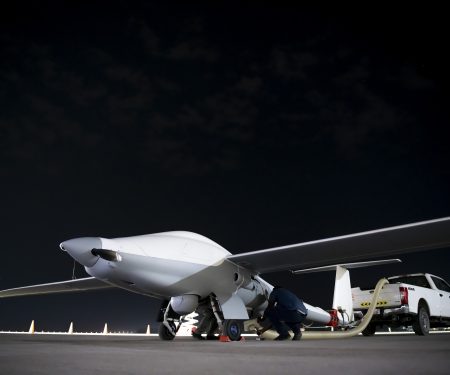Technical Sergeant Promotions Surge in 2025, to 1 in 4
Lawmakers Urge Air Force, SOCOM to Collaborate on New Long-Range Surveillance Drones
Dual-Use Military and Civil Airports Face Cyber Threats—and Policy Challenges
F-15EX and Its Electronic Warfare Suite Both Face Supply Chain Issues: Watchdog
Radar Sweep
Trump Announces Israel-Iran Ceasefire
President Donald Trump on June 23 announced a ceasefire between Israel and Iran after a nearly two-week war between the two countries. Trump, in a post on Truth Social, said that the ceasefire will take effect just after midnight on the East Coast of the United States, with the war slated to officially end 12 hours later.
VIDEO: Iran Strike on US Air Base in Qatar ‘Theater’ Not War, Says Retired Air Force Lt. General
David Deptula, retired lieutenant general in the U.S. Air Force, said the June 23 strike on the U.S. air base in Qatar was mainly symbolic, calling it “theater” amid reports Iran gave Qatar a heads up about the missiles.
US Investigates How Much of Iran’s Nuclear Program Was Destroyed—And How Much Remains
Trump administration officials said June 22 that the air and missile strikes against Iran’s nuclear infrastructure were a devastating blow that has likely set back Iran’s nuclear program for years. But Israel and the U.S. could nonetheless find the decadeslong battle they have waged against Tehran’s nuclear activities could continue indefinitely if the Iranians managed to relocate some of their stocks of highly enriched uranium and other equipment before the U.S. military attacked.
NATO Leaders Are Set to Agree a Historic Defense Spending Pledge, but the Hike Won’t Apply to All
The head of the NATO military alliance warned Monday that no country could have an opt-out from a massive new hike in defense spending, and that progress they make toward reaching the new target will be reviewed in four years. ... However, Spain said that it has reached a deal with NATO to be excluded from the 5 percent target, while President Donald Trump said the figure shouldn’t apply to the United States, only its allies.
‘Bunch of SCARS’: Space Force’s Hammett Speeds Phased Array Antenna Integration
The Space Force hopes to soon be able provide new orbital warfare capability to operators through integrating the modern phased-array antennas being developed under its Satellite Communications Augmentation Resource program with its R2C2 satellite command and control software, according to senior program officials.
Cyber Command Supports Strikes on Iran’s Nuclear Facilities, but Officials Keep Details Under Wraps
U.S. Cyber Command played a role in American military’s operation against Iranian nuclear facilities over the weekend, according to top Pentagon officials. ... Although details about Cybercom’s assistance for Operation Midnight Hammer, the code name for the strikes, remain murky, experts—most of whom spoke to DefenseScoop on condition of anonymity—outlined a number of possibilities for how the organization may have contributed to the effort.
Established Defense Contractors Lend Tech Startups a Helping Hand
In an age where the Pentagon is increasingly likely to tap newer tech companies like Palantir and Anduril to lead a program, older defense companies are looking to pay it forward with promising startups—and learn from them in return.
PODCAST: China In Space: Deterring Hostile Use of Force
The U.S. must deter China from using hostile force in space. Experts from Air University’s China Aerospace Studies Institute, in partnership with the Center for Naval Analysis, just released a new report suggesting that while conflict in space is not inevitable, the U.S. security establishment has a long way to go when it comes to boosting America’s ability to deter conflict on orbit.
York Space Launches US Military Satellite on SpaceX Rideshare
A U.S. military satellite built by York Space Systems launched to orbit June 23 aboard a SpaceX Falcon 9 rocket. The spacecraft, named Dragoon, lifted off from Vandenberg Space Force Base in California as part of SpaceX’s Transporter-14 mission—a rideshare flight carrying dozens of small satellites for government and commercial customers.
Pringles Cans on Drones: Ukraine’s Weapons Ingenuity Takes All Forms
“I don’t need your f---ing American shells,” Vadim Adamov muttered as he packed the Pringles can full of sulphate and plastic explosive. It was early 2024, and he had been fighting outside Avdiivka, a small town near the occupied city of Donetsk that had been a major Russian target since the start of the war.
The Surprising Importance of Magnets in Military Technology
Semiconductors and batteries are integral to vital technologies we use every day, from smartphones to data centers. This is especially true for the United States military. The federal government and the Pentagon acknowledge the nation’s dependence on foreign supply chains for its semiconductors and batteries, which are critical components in military equipment, such as radios and missiles. ... However, there’s one more component the country and the military are dependent on that hasn’t been addressed yet: magnets.





